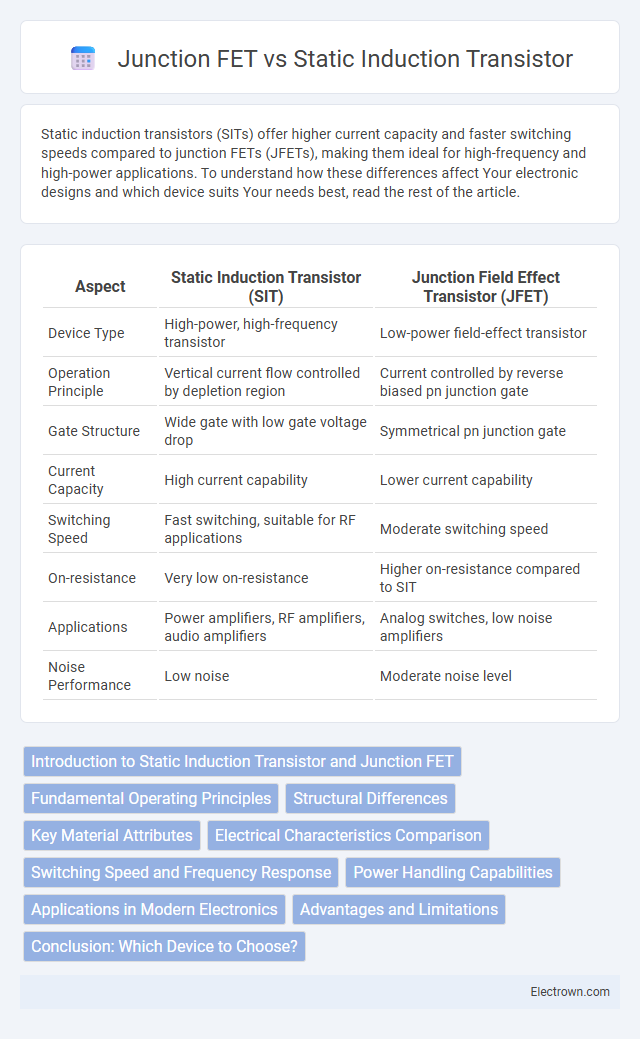Static induction transistors (SITs) offer higher current capacity and faster switching speeds compared to junction FETs (JFETs), making them ideal for high-frequency and high-power applications. To understand how these differences affect Your electronic designs and which device suits Your needs best, read the rest of the article.
Table of Comparison
| Aspect | Static Induction Transistor (SIT) | Junction Field Effect Transistor (JFET) |
|---|---|---|
| Device Type | High-power, high-frequency transistor | Low-power field-effect transistor |
| Operation Principle | Vertical current flow controlled by depletion region | Current controlled by reverse biased pn junction gate |
| Gate Structure | Wide gate with low gate voltage drop | Symmetrical pn junction gate |
| Current Capacity | High current capability | Lower current capability |
| Switching Speed | Fast switching, suitable for RF applications | Moderate switching speed |
| On-resistance | Very low on-resistance | Higher on-resistance compared to SIT |
| Applications | Power amplifiers, RF amplifiers, audio amplifiers | Analog switches, low noise amplifiers |
| Noise Performance | Low noise | Moderate noise level |
Introduction to Static Induction Transistor and Junction FET
Static Induction Transistors (SITs) are high-speed, high-power devices featuring a vertical structure that enables low on-resistance and fast switching, ideal for power amplification and RF applications. Junction Field-Effect Transistors (JFETs) operate as voltage-controlled resistors with a simple, planar design, providing low noise and high input impedance primarily used in analog circuits. Your choice between SIT and JFET depends on the application's demands for power handling, speed, and signal integrity.
Fundamental Operating Principles
Static induction transistors (SITs) operate by controlling current flow through a depletion layer modulation in a vertical structure, enabling high-speed switching and low distortion. Junction FETs (JFETs) function by modulating the conductivity of a semiconductor channel via reverse-biased PN junction gates to regulate current flow. Your choice depends on application needs, as SITs excel in high-frequency, high-power scenarios, while JFETs are preferred for low-noise analog circuits.
Structural Differences
Static induction transistors (SITs) feature a vertical structure with a thin, wide channel and a short gate length, allowing for high current capacity and fast switching. In contrast, junction field-effect transistors (JFETs) have a lateral structure with a longer channel and a pn-junction gate, which controls current flow through depletion regions. Your choice between these devices depends on requirements for power handling, switching speed, and structural robustness in high-frequency applications.
Key Material Attributes
Static induction transistors (SITs) utilize wide bandgap semiconductor materials such as silicon carbide (SiC) to achieve high electron mobility and superior thermal conductivity, enabling high-power, high-frequency operation and excellent heat dissipation. Junction Field-Effect Transistors (JFETs) primarily use silicon or gallium arsenide (GaAs) with narrower bandgaps, resulting in lower breakdown voltages and less efficient thermal performance compared to SITs. The SIT's unique vertical structure and material composition provide enhanced current density and faster switching capabilities relative to the lateral channel design and material limitations of JFETs.
Electrical Characteristics Comparison
Static Induction Transistors (SITs) exhibit higher current density and lower on-resistance compared to Junction Field-Effect Transistors (JFETs), enabling superior power handling and efficiency. SITs operate with a normally-on characteristic and demonstrate faster switching speeds, while JFETs are typically voltage-controlled with relatively slower response times. Understanding these electrical characteristics helps optimize Your circuit design for high-frequency and high-power applications.
Switching Speed and Frequency Response
Static induction transistors (SITs) exhibit faster switching speeds compared to junction field-effect transistors (JFETs) due to their vertical structure and low gate capacitance, enabling improved frequency response in high-frequency applications. SITs operate effectively in the megahertz to gigahertz range, making them suitable for RF amplifiers and power switching devices, while JFETs generally show slower switching speeds and limited frequency response in the lower megahertz range. The higher carrier mobility and reduced charge storage in SITs enhance their performance in high-speed switching and high-frequency circuits relative to conventional JFETs.
Power Handling Capabilities
Static induction transistors (SITs) exhibit superior power handling capabilities compared to Junction FETs (JFETs) due to their vertical structure and low on-resistance, enabling high current densities and voltages above 1 kV. SITs are preferred in high-power applications such as RF amplifiers and power inverters, where efficient heat dissipation and robust performance are critical. In contrast, JFETs typically operate at lower voltages and currents, making them less suitable for heavy power loads.
Applications in Modern Electronics
Static induction transistors (SITs) excel in high-frequency power amplification and radio frequency applications due to their superior high-speed switching and low distortion characteristics. Junction field-effect transistors (JFETs) are predominantly used in low-noise amplifiers, analog signal processing, and as voltage-controlled resistors in modern electronics. The choice between SITs and JFETs depends on the required power handling, frequency response, and noise performance in applications such as RF transmitters, audio equipment, and precision instrumentation.
Advantages and Limitations
Static induction transistors (SITs) exhibit higher power handling and faster switching speeds compared to junction FETs (JFETs), making SITs ideal for high-frequency and high-power applications such as RF amplifiers and power electronics. SITs offer low on-resistance and high breakdown voltage, enhancing efficiency and thermal stability, whereas JFETs typically provide simpler fabrication and lower noise levels suitable for low-power analog circuits. Limitations of SITs include complex manufacturing processes and higher cost, while JFETs suffer from lower current capacity and slower switching speeds, restricting their use in high-power systems.
Conclusion: Which Device to Choose?
The Static Induction Transistor (SIT) offers superior high-frequency performance and higher current capacity compared to the Junction Field Effect Transistor (JFET), making it ideal for power amplification and RF applications. JFETs provide lower noise and simpler fabrication, which suits low-power, low-noise analog circuits better. Choosing between SIT and JFET depends on the specific application requirements: prioritize SIT for high-power, high-speed needs and JFET for low-noise, low-power situations.
Static induction transistor vs Junction FET Infographic

 electrown.com
electrown.com